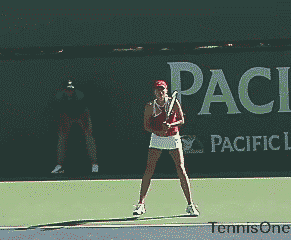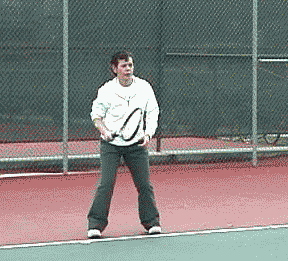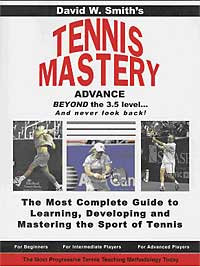|
TennisOne Lessons Developing a Practice Plan to meet your Tennis Goals Dave Smith TennisOne Senior Editor In this first of two parts on developing a practice plan to reaching your tennis goals, I wanted to address the concept of setting realistic goals as well as offering advice and motivation for each of you to know what is really possible in the way of tennis improvement. Next month, in Part II of this series, I will outline the practice plans and routines that we use in our tennis academy and those which have provided long-term improvement and progression for all our students.
Approach to Tennis Of the many questions and comments I have received regarding tennis instruction, some have nothing to do with grips, swing paths, footwork patterns, or spin. What I am often asked is, “How should I go about learning tennis?” In the fitness industry, we have identified many elements that dictate a person’s decision to get in shape. I see a commonality in the tennis teaching/learning environment that parallels these decision-making elements seen in the fitness industry. In addition, the ability of a person to successfully stay with a program long enough to enjoy the fruits of their fitness labor also have similarities when people want to learn to play tennis. One of the concerns among those in the tennis industry is the high number of players who start tennis but don’t stay with it beyond an initiating experience. Decision to Learn Similar to those looking to start a fitness program, potential tennis players usually make some initial commitment to learn tennis. While it may be obvious to some people, having a personal trainer greatly increases both the productivity as well as the propensity to stay with a fitness program. Likewise, tennis players usually do much better when introduced to tennis through the guidance of a tennis teaching professional. People who participate in tennis programs—those designed by qualified professionals—which include various sub-programs (ie: competition, drills, games, social elements), generally stay with the game for a long time…if not a lifetime. Having a hitting partner, a team, or a personal tennis trainer (pro), increases the longevity of a person enjoying the sport.
Method of Learning Most people who decide to play tennis follow one of two paths: they either figure they can learn tennis on their own or they decide to take tennis lessons. Those who look to learn to play on their own can be divided into two sub groups: Those who simply try and figure out how to play through trial and error; and those who study the game through books, videos, DVD’s, or instructional tennis web sites such as TennisOne.com. The latter group has a much greater chance at reaching higher levels of skilled play than those who learn through trial and error. Obviously, those who take lessons usually progress faster and with more enjoyment. The feedback, on-court instruction, opportunity to hit many balls in succession with specific intentions, and the advice of a pro that can identify areas to specifically work on offers far more efficient learning method. In addition, players who learn through trial and error seldom grasp the methods that lead to skilled play. Since the more advanced grips, swing patterns, and footwork patters tend to be unfamiliar and uncomfortable, most players would never think to try such uncomfortable techniques on their own. Depending on the ability of a player to self-analyze, to understand what their body is doing (as it relates to hand-eye coordination, swinging an implement, and footwork patterns), and to recognize corrections as needed and where needed, a player runs the risk of developing undesirable skills, many of which may be nearly impossible to correct or overcome. One of the best investments a person can make is taking tennis lessons. The concept of increasing one’s knowledge of the game, to understand proper techniques in which to practice, and to understand playing strategies, certainly increases the chance of improvement over time. There is nothing worse to me than to see players working on poor mechanics and stroke elements that will have to change if the player ever hopes to reach their potential. But this article is not directed necessarily to those who need to make subtle to significant changes in their games. (However, the steps within this article are indeed necessary for such changes to occur!) My intention here is to provide anyone interested a learning guideline that increases the probability of tennis mastery within every player’s interest and desire. Goals: Initial and Changing It is interesting to hear how many people approach the aspect of learning tennis depending on age and perception of their potential. Generally, younger kids have an inflated view of how good they want to be. You hear some say they want to be “Number one in the world!” or, “The best in the U.S.!” These statements are usually based on two things: a lack of knowing what it takes to be that good, and, usually, a sense of inhibition. Adults, on the other hand, project nearly a polar opposite: they say things like, “I just want to learn how to get the ball over the net,” and “I don’t want to be great or anything.”
In my experience, while both perceptions are faulty, I like the belief that juniors have that they have every chance to make it to the top. While it is unlikely for most juniors to move to such levels, I never try to discourage those dreams. I have found that becoming a tennis champion has more to do with desire and effort than it does with any amount of labeled potential. At the same time, adults severely limit their potential from the start by establishing goals that are minimal at best. (In reality, most adults have much higher goals but don’t want to admit them for fear of falling short.) I have taught many 50 and 60 year old men and women who far exceeded their own expectations, (once they discovered their own mindset was their biggest hindrance!) And, my biggest group of successful students (next to my juniors) would have to be women in their 30’s. These women discovered they could not only enjoy skilled tennis (many of which found that they could compete with their children who had become or were becoming skilled players themselves!), but also compete at levels they had never thought possible! Adult men in their 30’s are interesting as many have developed sport skills that can be complementary to tennis, whereas others may believe they can pick up tennis quickly (because they played other sports) only to discover the sport far more demanding than they had thought.
In reality, I don’t know too many players who pick up a tennis racquet and say, “Gee, I would love to play tennis but I really don’t want to be any good.” Most people would like to see (and probably aspire, secretly or otherwise!) how good they could become. Most everyone has watched tennis played either at the professional level or at a club where some really good players were competing. Such skill-levels make tennis look really fun. Rallies with firm strokes, crisp volleys, angles and touch, disguise and power, demonstrate both the diversity and creativity skilled players can create. Spectators often can be heard ‘oohing and aahing’ at such exhibitions, and wishing they could play at that level. But, the real fun in tennis is to see consistent improvement and to experience the likelihood of reaching higher levels of play instead of stagnating and never having the hope of getting better. Such fun is long-lasting. It is more sustaining from a human nature standpoint instead of one that is based on short term or immediate gratification that can result from less difficult methods, but methods that don’t lend themselves to higher levels of mastery. If a player learns proper stroke, grip, and footwork techniques, it is likely that they will develop new goals. These players see themselves progressing nicely and discover that they are not that different than the top players they looked up to. At this point, I often see students attack learning with a new-found inspiration. There is something about knowing you are learning the right ways that makes you want to work at it that much harder. Those who build their foundation based on inferior techniques often find trying to improve their game an experience in futility: on one hand they know working harder on their flawed games won’t help them become more prolific players; and on the other hand, making significant changes is so frustrating and uncomfortable that such change is nearly impossible. Short term expectations need to be congruent with long term expectations. That is, your short term expectations should be congruent with your long term goals. You certainly wouldn’t want to master the eastern forehand grip on the volley or serve as a short term goal if your long term goal is to hit these shots with a continental grip. Unfortunately, this is how many players are introduced to tennis. A common misconception of teaching tennis is that it is productive to not challenge a student and get them ‘playing’ tennis quickly using what ever grip/swing pattern works best at that moment. If a player wishes to reach his potential, then this is perhaps the most detrimental philosophy in the tennis teaching community. ‘Playing’ tennis at this level is not only subject to a ‘dinking’ mentality, it seldom contributes to the long term progression towards playing tennis within a skilled manner. Developing a Practice Plan is subject to understanding the concepts I have just discussed. Your true potential in tennis is defined by four distinctive rationales:
When players understand their potential is broken down into these four parts, it becomes more manageable for them to develop a practice plan that will work best. Your comments are welcome. Let us know what you think about Dave Smith's article by emailing us here at TennisOne .
TENNIS MASTERYFinally. a resource that unlocks these mysteries: • Why do m • Why are making changes in one's game so frustratingly difficult? • What tennis teaching methods are disruptive or detrimental to player progression? Read David W. Smith's TENNIS MASTERY and learn not just how to avoid playing at mediocre levels, but how the best players in the world Master the sport of tennis! "With a depth of knowledge and fresh perspective, TENNIS MASTERY is set to become a manual for tennis instructors and a measure for tennis literature." Richard Wigley, Director, Kayenta Tennis Center, Ivins Utah. Take in David Smith's 30 plus years in the tennis teaching industry. This 335-page manual will provide for every level of player as well as support for all tennis-teaching professionals, a blueprint for reaching higher levels of tennis mastery. Order TENNIS MASTERY at tenniswarehouse.com , or go to tennismastery.net for exciting excerpts from the book and a host of tennis information! And check out David Smith's other articles found here at TennisONE.com Learn more from Dave Smith at his Desert Shadows Tennis Institute!
Next available DSTI camps are November 28th - 30th and December 5th - 7th! Space is limited! Call (435) 628-5000 and ask for the tennis pro shop to learn more about Desert Shadows Tennis Institute. Learn the Advanced Foundation, discover tools to master more advanced techniques for all strokes, and discover that staying at the same level you are is NOT AN OPTION! A select number of camps are available but space is very limited. The DSTI camps take place in St. George, Utah, in the heart of ‘Color Country’—the incredible beauty of Southern Utah. Zion, Bryce Canyon and Grand Canyon National Parks are all nearby! Hurry to reserve your spot now for a true ‘tennis destination’ opportunity! “The most informative, intuitive tennis camp I have ever attended.” Randy S. Colorado “Dave and his staff have a passion for the game and a personal care for their students.” S. Loo, Nevada “The depth of instruction is far superior to that of other tennis camps I’ve been.” Tom T. Nevada |




 illions of tennis players stagnate at levels far below their potential?
illions of tennis players stagnate at levels far below their potential?  Join Dave Smith in an intimate, ultimate tennis camp: Desert Shadows Tennis Institute (DSTI) is an intense, 3-day camp that accepts only 12 players to work directly with Dave and his staff of certified and accomplished pros. Over 18 hours of tennis instruction is included along with a copy of Dave’s best-selling tennis book, TENNIS MASTERY, a DVD of instruction, breakfast and lunch each day, and a lifetime of tennis secrets!
Join Dave Smith in an intimate, ultimate tennis camp: Desert Shadows Tennis Institute (DSTI) is an intense, 3-day camp that accepts only 12 players to work directly with Dave and his staff of certified and accomplished pros. Over 18 hours of tennis instruction is included along with a copy of Dave’s best-selling tennis book, TENNIS MASTERY, a DVD of instruction, breakfast and lunch each day, and a lifetime of tennis secrets!